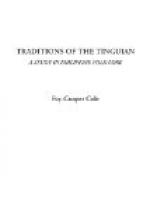[131] See p. 35, note 1.
[132] See p. 42, note 1.
[133] Piper sp.
[134] See p. 18, note 1.
[135] See p. 17, note 3.
[136] A powerful spirit.
[137] See p. 30, note 3.
[138] See p. 12.
[139] See p. 7, note 1.
[140] The story tellers explain the very frequent mention of “girls who always stay in the house” or “who never go out of doors” by saying that in former times the prettiest girls were always protected from the sunlight in order that their skin might be of light color. These girls were called lala-am—those within. It is not thought they remained constantly within doors.
[141] See p. 11.
[142] See p. 12.
[143] See p. 13, note 1.
[144] See p. 14, note 2.
[145] See p. 13, note 2.
[146] Small covered benches built during the Sayang ceremony for the use of spirits and mortals.
[147] See p. 11.
[148] See p. 17.
[149] See p. 11.
[150] Each type of jar has its special name.
[151] See p. 12.
[152] This was the tadek. See p. 11, note 3.
[153] Similiar ideas appear in tales from Borneo. See p. 15, note 1.
[154] Ilangilang.
[155] It is still considered a bad sign if anything falls or breaks at a wedding.
[156] Apparently Gawigawen had not been present at the pakalon. Such a condition frequently exists nowadays.
[157] See pp. 12, 128.
[158] A minor spirit.
[159] King or ruler.
[160] This seems to be a late unconnected, intrusion into the tale. The ati and soldiers are entirely foreign to the Tinguian.
[161] See p. 12.
[162] This incident is frequently found in these tales. It also occurs in Javanese literature. See Bezemer, Volksdichtung aus Indonesien, p. 47. (Haag, 1904).
[163] See p. 15.
[164] Kadayadawan is re-named Aponitolau by his new-found parents.
[165] A powerful spirit.
[166] See p. 54, note 2.
[167] The story teller paused here to explain that his mother did not know that she was pregnant, and that a miscarriage had occurred.
[168] See p. 63, note 1.
[169] Head man.
[170] The term used is alopogan, which means “she who covers her face.” For lack of a better designation we shall call her a medium. See p. 23.
[171] See p. 41, note 2.
[172] A bird.
[173] Copper gong.
[174] See p. 59, note 1.
[175] It is the custom to distribute a part of the marriage price among the relatives of the bride.
[176] The groom’s gift.
[177] See p. 11, note 5.
[178] The term which expresses the relationship established between the parents of the bride and groom.




